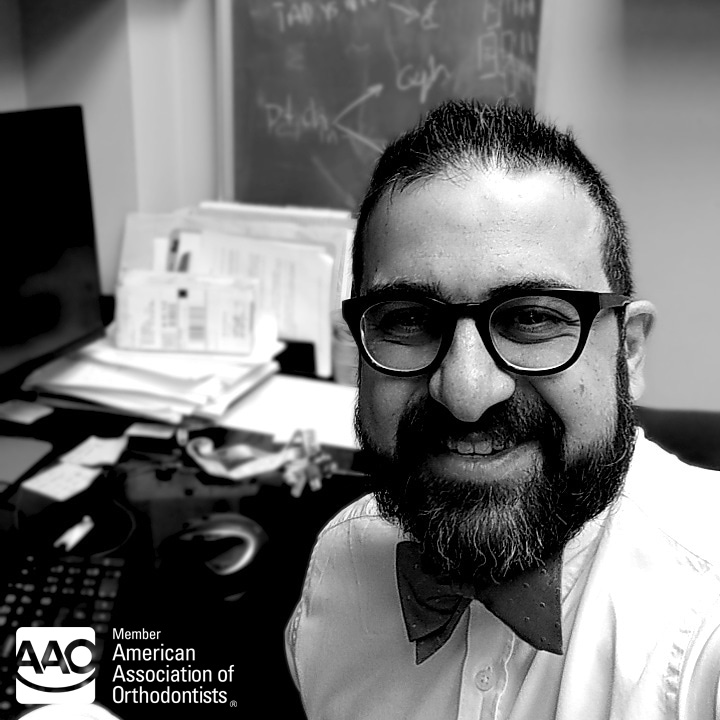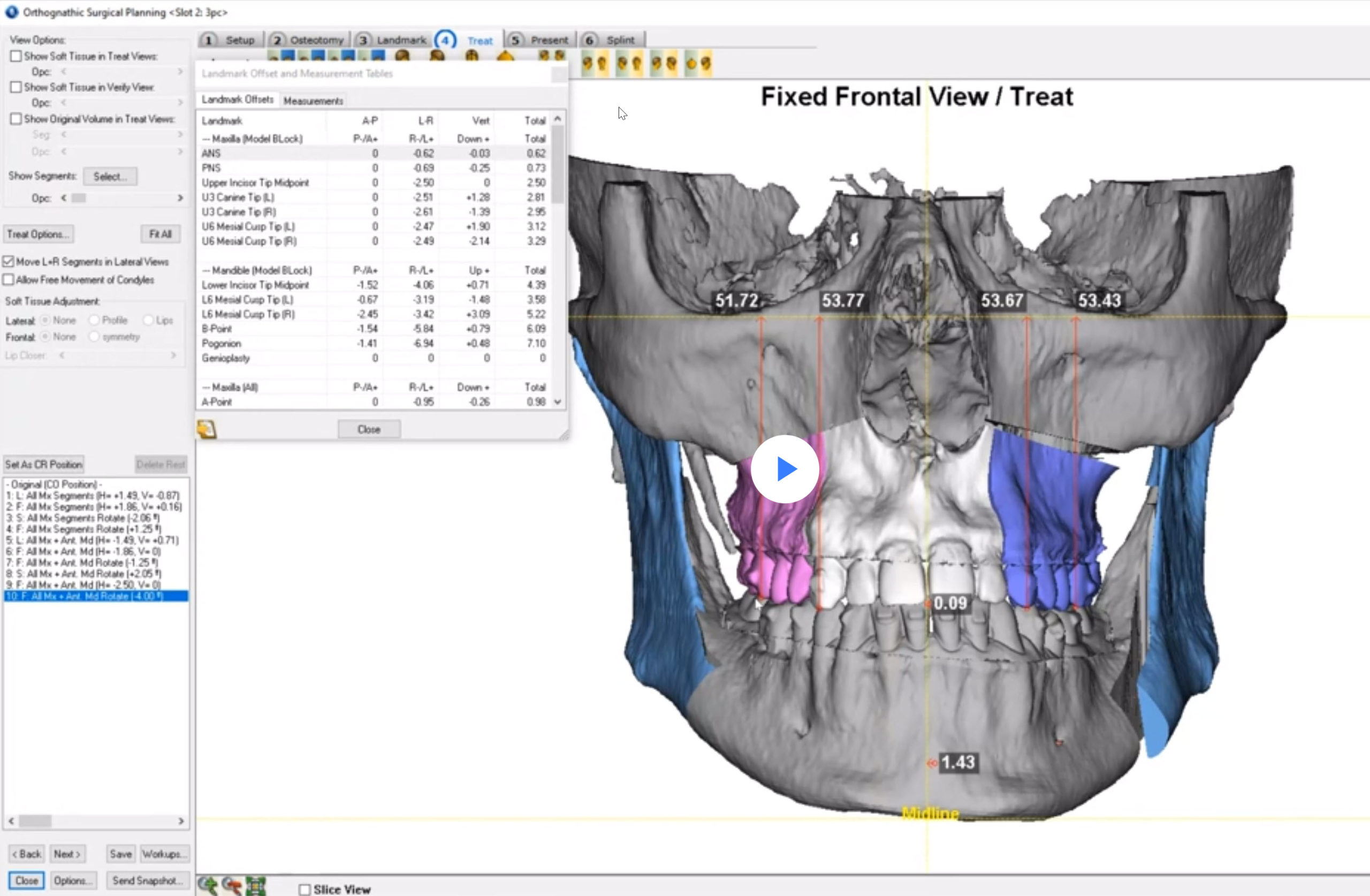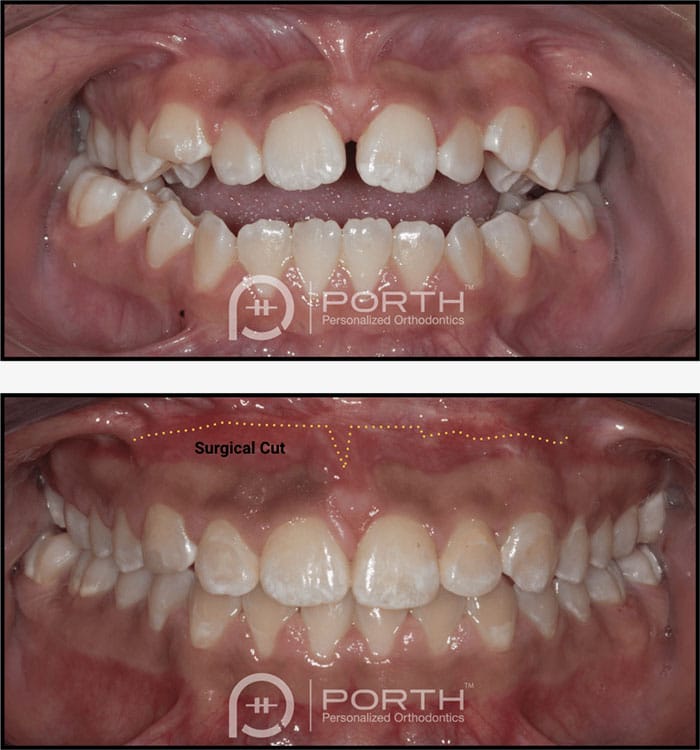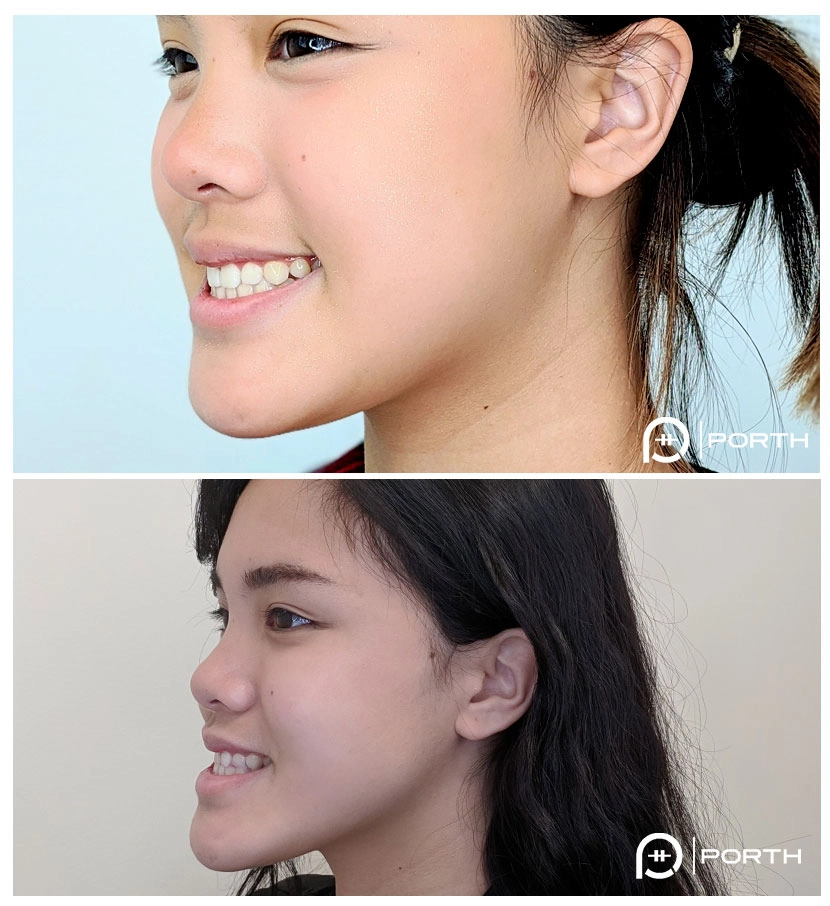Jaw Surgery
Corrective orthognathic surgery combined with orthodontic treatment.
About Corrective Jaw Surgery (Orthognathic Surgery)

For certain patients, orthodontic treatment alone cannot completely address their dental and skeletal issues.
If the root of the problem is the alignment of the jaw—stemming from atypical skeletal growth—surgery accompanied by braces may be the best choice to correct the bite.
Corrective jaw surgery, also known as orthognathic surgery, is performed by an experienced oral surgeon. This procedure involves precise incisions to improve accessibility to the jaw joint and surrounding bone structures. It is typically conducted under general anesthesia, ensuring patient comfort and safety throughout the process of moving the jaws in correct positions.
Corrective jaw surgery addresses a range of issues, from a protruding jaw and bite problems to breathing difficulties and complications arising from facial injuries.
The surgery aims to enhance oral health and functionality by correcting misalignments that can lead to significant discomfort and health issues.
Surgical planning is a critical phase, often incorporating the removal of wisdom teeth to prevent future complications and ensure optimal outcomes. These surgical procedures are tailored to each patient's specific needs, taking into account the severity of the condition and the desired aesthetic and functional results.
Through careful planning and execution, corrective jaw surgery can alleviate discomfort, improve the ability to chew and speak, and enhance overall appearance, offering a comprehensive solution to complex dental and facial concerns.
Jaw surgery can, in some cases, result in drastic changes to the patient's appearance, especially in those with a strong lower jaw. This transformative potential underscores the importance of thorough consultation and planning to achieve the best possible outcome.
Patients often have lots of questions about jaw surgery including the aligners or braces cost for corrective jaw surgery. Keep reading to find answers to all your questions.
Conditions that may indicate the need for corrective jaw surgery
Difficulty chewing or biting food
It can be difficult to chew food at a normal rate without pain or discomfort if the jaws are not in proper alignment. This imbalances can negatively impact a patient’s quality of life. Misaligned jaws won't function well.
Receding or protruding lower jaw and chin
Sleep disorders
Jaw surgery is one option for helping patients with sleep apnea. This procedure helps the jaws, tongue and throat to move forward creating more space in the airway path.
Injury or birth defects
Unbalanced facial appearance from the front or side
This cosmetic concern is often indicative of jaw alignment issues. Chin augmentation or reduction is one of these cosmetic procedures.
Identifying the Need for Jaw Surgery
Causes of Jaw Alignment Issues
Jaw alignment problems can originate from several different factors.
In some cases, the patient's upper and lower jaws may have grown at different rates, leading to malocclusion in the upper and lower teeth. The most prevalent jaw problem is a small lower jaw (commonly referred to as an overbite), and the second most common issue is a protruding lower jaw (a strong jaw with crossbite).
Patients with congenital cleft palate and cleft lip often have various malocclusions that require corrective jaw surgery.
Identifying the Need for Jaw Surgery
In most cases, your dentist or orthodontist will be able to determine fairly early on if you might require jaw surgery.
Misaligned jaws can lead to temporomandibular joint (TMJ) disorders, breathing problems, mouth breathing, and aesthetic concerns such as a receding chin. Genetics plays a strong role in atypical skeletal growth, which can result in jaw alignment issues.
Complimentary Consultation at PORTH
We provide a complimentary consultation for corrective jaw surgery at PORTH. Dr. Rooz will discuss the details of your orthodontic treatment along with your jaw surgery.
Our personalized approach ensures high-quality, cost-effective treatment to move your teeth into their correct positions and improve both function and appearance. We are committed to providing exceptional dental care throughout your treatment journey.
Asymmetrical Skeletal Problems
Asymmetric skeletal problems are generally detectable during adolescence and are another reason for corrective jaw surgery.
For example, an asymmetrical lower jaw creates an uneven bite, which can lead to the teeth suffering more wear and tear than properly aligned teeth. Birth defects, injuries, and other damage may also impact your jaw alignment.
Preparing for Jaw Surgery

When it comes time to prepare for your jaw surgery, your dentist, orthodontist, and oral and maxillofacial surgeon will work together to determine the best course of action for your individual needs.
As your healthcare providers, they will ensure you receive comprehensive care tailored to your specific condition. There are many different types of jaw surgery available to address various issues, including facial asymmetry and other skeletal discrepancies.
The oral and maxillofacial surgeon ultimately determines—which involves evaluating 3D radiographs (also known as X-rays)—which corrective jaw surgical procedure is appropriate, and performs the surgery itself.
This may include procedures such as bone grafting. For certain patients dental implants could also placed during surgery.
It's important to understand that the treatment, which usually includes orthodontics before and after the actual surgery, may take a few years to complete. During this time, orthodontic appliances like braces, elastics, and eventually retainers, will be used to move your teeth into their correct positions.
This is a long-term commitment, and your medical professionals will do their best to realistically estimate the time required for your treatment. They will guide you through each stage, ensuring you are informed and comfortable with the process.
Of course, every patient’s situation is different in terms of the degree of misalignment. Your orthodontist and maxillofacial surgeon will create a specific treatment plan for you.
Nonetheless, most treatment plans include specific stages to address both functional and aesthetic concerns. Modern dentistry has advanced significantly, allowing for effective treatments that improve not only oral health but also overall esthetic and function.
Surgery-First Approach
In certain cases, surgery is performed before any orthodontic treatment. Here, the maxillofacial surgeon conducts corrective jaw surgery without prior orthodontic care, and the orthodontist provides treatment afterward.
This approach has its advantages and disadvantages, depending on the patient's specific conditions. Your orthodontist and surgeon will discuss this option with you if they believe it may be suitable.
Orthodontic Treatment Before Surgery
Orthodontic treatment is typically required both before and after jaw surgery to prepare and optimize your bite. Initially, orthodontists adjust the position of your teeth to align with the anticipated new position of your jaws.
During this pre-surgical phase, you may notice your bite becoming more misaligned because the treatment reverses the body's natural compensations for the existing misalignment. For example, some patients may develop a temporary underbite before surgery. Once the surgery is complete, your teeth and jaws will align properly, resulting in a correct bite.
Common Correction Procedures
Depending on the patient’s needs, bone may be added, taken away, grafted, or reshaped. Surgical plates and screws are often used to hold the jaws in the new positions, while wires and rubber bands may be used in conjunction with the patient’s braces to hold their jaws in their new position until the bones have healed.
Openbite

To surgically correct an open bite, the plan can involve one or two jaw surgeries. The origin of anterior open bite as well as esthetic aspects of smile determine the surgical approach to move jaws toward each other.
Setting lower jaw back

To surgically correct a protruded lower jaw, also known as an underbite, the bone in the back portion of the lower jaw is separated from the front portion of the jaw and modified so that the front, tooth-bearing portion of the lower jaw can be moved back. Moving lower jaw back is sometimes accompanied with moving the upper jaw for a better coupling and esthetic reasons.
Moving lower jaw forward

To surgically correct a small receding lower jaw, the bone in the lower jaw is separated from its base. The tooth-bearing portion of the lower jaw and chin are then repositioned forward.
Case Study
Megan's Experience with Corrective Jaw Surgery
The Recovery Process: What to Expect

Your recovery process will vary in length and difficulty depending on your own situation and the degree of correction that was needed. For example, patients that only require surgery on the lower jaw rather than both jaws will typically experience a quicker recovery.
In order to get a better sense of what your own recovery process will be like, talk to your maxillofacial surgeon about your specific case. Many jaw surgery patients have documented their recovery journeys through blogs and YouTube videos, such as this video about double jaw surgery and this video about open bite corrective surgery.
How long do patients stay in the hospital?
When can I go back to work after jaw surgery?
The time it takes to return to your normal, daily life depends on the severity of your surgery and the nature of your work. Generally, patients take about 1-3 weeks off from work.
If your job requires a lot of speaking or physical activity, such as teaching, personal training, or manual labor, you will need to take a little more time off of work. If you work from home or spend most of your time working quietly at a computer, you will be able to go back to work sooner.
How long does your mouth stay wired shut after jaw surgery?
Most surgeons no longer wire patients’ jaws shut after surgery. Instead, they use tight rubber bands to keep the teeth in place. Most patients have rubber bands for 3-5 weeks to help train the jaw to learn the new bite.
The bands are gradually loosened at subsequent follow up appointments with the surgeon. If you will require rubber bands for longer, your surgeon and orthodontist will be able to give you an estimated time frame.
Book a Free Consultation!
Start a virtual complimentary consultation today or schedule an in-person appointment at our orthodontic offices in Sammamish or Bellevue. Your first free appointment includes recommendations for orthodontic treatment.
Orthodontist & Oral surgeon comminucation
Our team is committed to provide the best quality care
Genioplasty (chin modification)
Orthognathic procedures encompass various surgeries, including upper jaw surgery (maxillary osteotomy) and repositioning of the lower jaw in the front to the back plane (sagittal plane).
In some patients, the upper (maxilla) and lower (mandible) jaws are properly aligned, but there are abnormalities in the chin bone—such as asymmetry, prominence, or a small chin. Surgical adjustment of the chin, known as genioplasty, can correct these issues without affecting the bite (occlusion).
Chin reconstruction, reduction, or augmentation can be performed alone or in combination with mandibular osteotomy (lower jaw surgery) or Le Fort I osteotomy (upper jaw surgery).
Underbite (strong lower jaw)
Skeletal orthodontic challenges, such as underbites where the lower teeth extend beyond the upper teeth, significantly affect facial aesthetics, chewing, and breathing.
To rectify these issues, orthodontists and oral and maxillofacial surgeons collaborate on a treatment plan that often incorporates orthognathic (corrective jaw) surgery. This surgery realigns the jawbones—notably the mandible (lower jaw) and maxilla (upper jaw)—to enhance bite function and facial symmetry.
Beyond cosmetic improvements, the surgery addresses functional problems like obstructive sleep apnea and temporomandibular joint (TMJ) disorders. It involves precise planning and is executed under general anesthesia.
Procedures such as mandibular and maxillary osteotomy correct jaw imbalances, and post-surgical orthodontic treatments like braces ensure proper teeth alignment. This comprehensive approach to jaw surgery tackles malocclusion due to misaligned jaws, enhancing both oral health and overall facial appearance.

Temporomandibular Joint (TMJ) Replacement
Severe TMJ tissue problems could lead in TMJ replacement. This is a surgical procedure common in correcting severe craniofacial abnormalities. Jaw bones and occlusion needs to be adjusted based on the new joint.
Orthognathic Surgery for Obstructive Sleep Apnea
A double jaw bone surgery to advance craniofacial structure is one of the solution to address obstructive sleep apean (OSA). Sleep apnea is a multi factorial condition and corrective jaw surgery might not completely resolve this issue. Discrepancies in soft and hard tissues lead to OSA.
